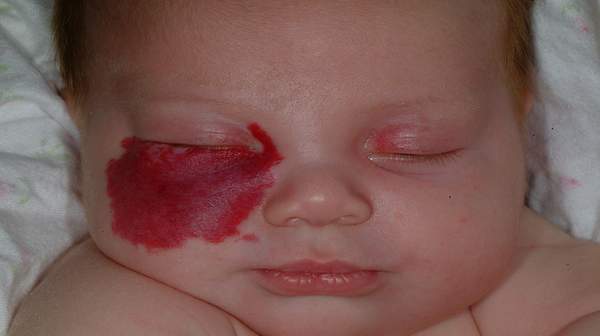What's in this article?
A hemangioma of the skin is an abnormal build up of blood vessels on or under the surface of the skin. Birthmark that most commonly appears as a rubbery, bright red nodule of extra blood vessels in the skin.
Sometimes called a strawberry mark, a hemangioma grows during the first year of life, and then recedes over time. A child who had a hemangioma during infancy usually has little visible trace of the growth by age 10.
A hemangioma can occur anywhere on the body, but most commonly appears on the face, scalp, chest or back. Treatment of a hemangioma usually isn’t needed, unless the nodule interferes with vision or breathing.
Hemangioma: A birth irregularity where a localized tissue mass grows rich in small blood vessels. Capillary hemangiomas are composed nearly entirely of tiny capillary vessels. Cavernous hemangiomas are composed of blood- filled “lakes” and channels.

An hemangioma may be visible through the skin as a birthmark, known colloquially as a “strawberry mark.” Most hemangiomas that occur at birth disappear after a few months or years.
They may occur anywhere on the skin surface but are most common on the scalp, face and neck. All skin hemangiomas are seen by 6 months of age.
What do hemangiomas look like?
Hemangiomas can occur anywhere on the skin but rarely in the organs of the body. Hemangiomas are most often found on the skin of the head or neck. They may be located in the outer layers of the skin (superficial hemangioma) or under the skin in the fat (deep hemangioma). Hemangiomas that are on the surface of the skin are typically bright red to purple in color, while deep hemangiomas may be blue, purple, or even normal skin color if they are located deep under the skin surface. Most hemangiomas are round or oval in shape, but larger lesions may follow the shape of the affected body part. The size of hemangiomas varies. Some are very small (1 mm), while others are very large (20 cm or larger). Every hemangioma differs in how fast it grows and how long it grows before it stops.
Symptoms of Hemangioma
Symptoms of a hemangioma are:
- A red to reddish-purple, raised sore (lesion) on the skin
- A massive, raised, tumor with blood vessels
Most hemangiomas are on the face and neck.
Incidence of Hemangioma
Hemangioblastomas represent about 2% of all primary brain tumors. About 10% of patients with hemangioblastoma have VonHippel-Lindau disease. If you have VonHippel-Lindau disease, you are more likely to be affected by this type of tumor, as well as tumors of the liver, pancreas, and kidneys.
Hemangioblastoma can occur at any age, but is most commonly found in people who are around 40.Hemangiopericytomas tend to affect younger people.
Do Birthmarks Need to Be Treated?
Most birthmarks need no treatment. They usually remain stable as a child grows older. However, some areas that can resemble blood vessel tumors called hemangiomas may need treatment because of their location. For example, a raised hemangioma near a child’s eye may interfere with his or her ability to see. In rare cases, birthmarks are associated with other conditions, such as growths on the liver, lungs, stomach, or intestines.
What causes an infantile Hemangioma?
The cause of an infantile hemangioma is not known. They are more common in girls than boys and are more often seen in Caucasian children. We have learned that hemangiomas are seen more frequently in babies born very small or those born several weeks before their due date. Thus far, we have not identified what may put these infants at risk. Research continues at Children’s to find the causes of hemangiomas so we can begin to prevent these lesions and control their growth.
Will my baby’s Hemangioma grow?
Infantile hemangiomas grow rapidly for the first few weeks or months. They enter a rest phase by about 8 months of age. They usually begin to shrink (involution phase) around one year of age. As the lesion shrinks, the color may change from red to purple and gray. It may take several years for the hemangioma to go away completely. Larger lesions take a longer time to go away and have a greater chance of scarring.
Hemangiomas and Your Skin
The hemangioma is a common type of vascular tumor which may occur early in life and resemble a birthmark. It is usually painless and harmless and its cause is not known. Color from the birthmark comes from the extensive development of blood vessels at the site.







